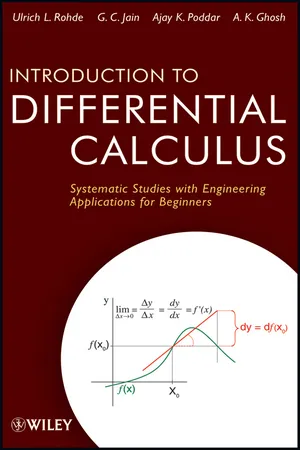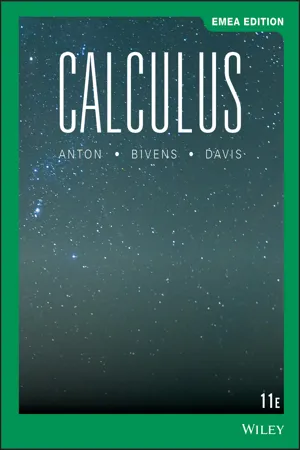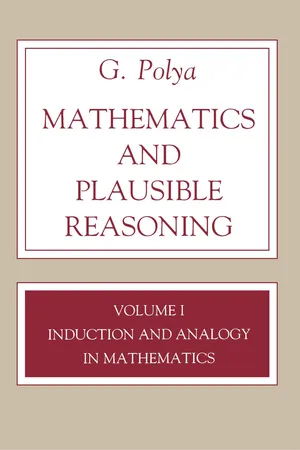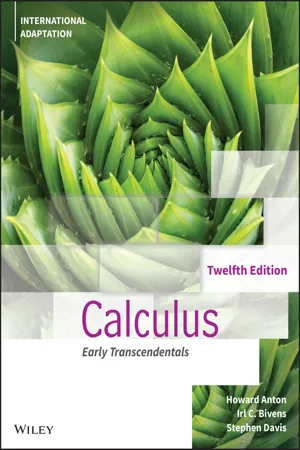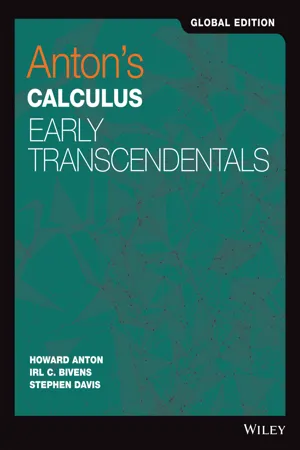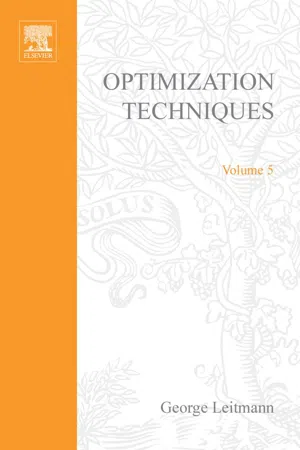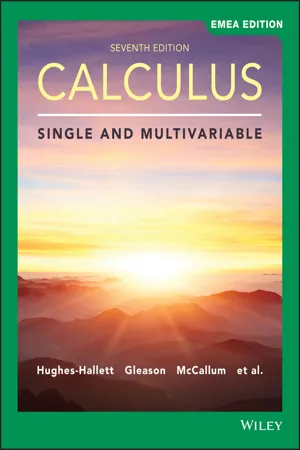Mathematics
Absolute Maxima and Minima
Absolute maxima and minima refer to the highest and lowest values of a function over a given interval or on a specific domain. These points represent the peak and trough of the function and are important in optimization problems and in understanding the behavior of functions. They are found by analyzing the critical points and endpoints of the function.
Written by Perlego with AI-assistance
Related key terms
1 of 5
10 Key excerpts on "Absolute Maxima and Minima"
- eBook - ePub
Introduction to Differential Calculus
Systematic Studies with Engineering Applications for Beginners
- Ulrich L. Rohde, G. C. Jain, Ajay K. Poddar, A. K. Ghosh(Authors)
- 2012(Publication Date)
- Wiley(Publisher)
greater than the maximum of the function at x = x 1 .Figure 19b.1At this stage, we introduce the following terms and concepts that will be frequently used in this chapter.- Absolute Maximum (Minimum) of a Function : In Figure 19b.1 , note that at x = b , the value of the function is greater than any maximum of the function on the interval [a , b ]. Thus, the greatest value of the function occurs at x = b , and similarly, the smallest value occurs at x = x 2 . We say that the absolute maximum of f is f (b ) and the absolute minimum is f (x 2 ).
- The Points of Extreme Values of a Function : The points like x 1 , x 2 , x 3 , x 4 , and b at which the extreme values of the function f occur , are called the points of extremum (or extreme) values of the function. Note that, a function defined on an interval can reach maximum and minimum values only for the points that lie within the given interval .1
Our interest lies in finding the points of extreme values of a continuous function by using the concept of the derivative . Once such points are known, it is easy to compute the extreme values of the function and then select the absolute extreme values, which have practical applications , as will be clear from some solved examples.In the case of some functions, it is not difficult to find the points of extrema without using calculus, but it will be seen that in general it is not possible to find the extreme values without applying differential calculus.2The knowledge of such points is very useful in sketching the graph of a given function. Besides, these extreme values have many practical applications in widely varying areas such as engineering and various sciences, and so on.
- eBook - PDF
Calculus
Late Transcendentals
- Howard Anton, Irl C. Bivens, Stephen Davis(Authors)
- 2021(Publication Date)
- Wiley(Publisher)
In this section we will be concerned with the more encompassing problem of finding the highest and lowest points over the entire mountain range, that is, we will be looking for the top of the highest hill and the bottom of the deepest valley. In mathematical terms, we will be looking for the largest and smallest values of a function over an interval. ABSOLUTE EXTREMA We will begin with some terminology for describing the largest and smallest values of a function on an interval. 3.4.1 DEFINITION Consider an interval in the domain of a function f and a point x 0 in that interval. We say that f has an absolute maximum at x 0 if f (x) ≤ f (x 0 ) for all x in the interval, and we say that f has an absolute minimum at x 0 if f (x 0 ) ≤ f (x) for all x in the interval. We say that f has an absolute extremum at x 0 if it has either an absolute maximum or an absolute minimum at that point. If f has an absolute maximum at the point x 0 on an interval, then f (x 0 ) is the largest value of f on the interval, and if f has an absolute minimum at x 0 , then f (x 0 ) is the smallest value of f on the interval. In general, there is no guarantee that a function will actually have an absolute maximum or minimum on a given interval. (See Figure 3.4.1 on the next page.) THE EXTREME VALUE THEOREM Parts (a)–(d) of Figure 3.4.1 show that a continuous function may or may not have abso- lute maxima or minima on an infinite interval or on a finite open interval. However, the following theorem shows that a continuous function must have both an absolute maximum and an absolute minimum on every finite closed interval [see part (e) of Figure 3.4.1]. The hypotheses in the Extreme-Value Theorem are essential. That is, if either the interval is not closed or f is not con- tinuous on the interval, then f need not have absolute extrema on the interval (Exercises 4–6). - eBook - PDF
- James Stewart, Daniel K. Clegg, Saleem Watson, , James Stewart, James Stewart, Daniel K. Clegg, Saleem Watson(Authors)
- 2020(Publication Date)
- Cengage Learning EMEA(Publisher)
Cengage Learning reserves the right to remove additional content at any time if subsequent rights restrictions require it. 210 CHAPTER 3 Applications of Differentiation Maximum and Minimum Values Some of the most important applications of differential calculus are optimization prob- lems, in which we are required to find the optimal (best) way of doing something. Here are examples of such problems that we will solve in this chapter: ● What is the shape of a can that minimizes manufacturing costs? ● What is the maximum acceleration of a spacecraft? (This is an important question for the astronauts who have to withstand the effects of acceleration.) ● What is the radius of a contracted windpipe that expels air most rapidly during a cough? ● At what angle should blood vessels branch so as to minimize the energy expended by the heart in pumping blood? These problems can be reduced to finding the maximum or minimum values of a func- tion. Let’s first explain exactly what we mean by maximum and minimum values. ■ Absolute and Local Extreme Values We see that the highest point on the graph of the function f shown in Figure 1 is the point s3, 5d. In other words, the largest value of f is f s3d - 5. Likewise, the smallest value is f s6d - 2. We say that f s3d - 5 is the absolute maximum of f and f s6d - 2 is the abso- lute minimum. In general, we use the following definition. 1 Definition Let c be a number in the domain D of a function f . Then f scd is the ● absolute maximum value of f on D if f scd > f s xd for all x in D. ● absolute minimum value of f on D if f scd < f s xd for all x in D. An absolute maximum or minimum is sometimes called a global maximum or mini- mum. The maximum and minimum values of f are called extreme values of f. Figure 2 shows the graph of a function f with absolute maximum at d and absolute minimum at a. Note that sd, f sd dd is the highest point on the graph and sa, f sadd is the lowest point. - eBook - PDF
Calculus
One and Several Variables
- Saturnino L. Salas, Garret J. Etgen, Einar Hille(Authors)
- 2011(Publication Date)
- Wiley(Publisher)
Endpoints in the domain of a continuous function which is differentiable at all points of the domain near that endpoint can be tested by examining the sign of the first derivative at nearby points and then reasoning as we did in Section 4.3. Suppose, for example, that c is a left endpoint and that f is continuous from the right at c. If f (x ) < 0 at all nearby x > c, then f decreases on an interval [c, c + δ) and f (c) is an endpoint maximum. (Figure 4.4.1) If, on the other hand, f (x ) > 0 at all nearby x > c, then f increases on an interval [c, c + δ) and f (c) is an endpoint minimum. (Figure 4.4.2) Similar reasoning can be applied to right endpoints. Absolute Maxima and Absolute Minima Whether or not a function f has a local extreme value or an endpoint extreme value at some point c depends entirely on the behavior of f at c and at points close to c. Absolute extreme values, which we define below, depend on the behavior of the function on its entire domain. We begin with a number d in the domain of f. Here d can be an interior point or an endpoint. DEFINITION 4.4.2 ABSOLUTE EXTREME VALUES The function f is said to have an absolute maximum at d provided that f (d ) ≥ f (x ) for all x in the domain of f ; f is said to have an absolute minimum at d provided that f (d ) ≤ f (x ) for all x in the domain of f . A function can be continuous on an interval (or even differentiable there) without taking on an absolute maximum or an absolute minimum. All we can say in general is that if f takes on an absolute extreme value, then it does so at a critical point or at an endpoint. 176 ■ CHAPTER 4 THE MEAN-VALUE THEOREM; APPLICATIONS OF THE FIRST AND SECOND DERIVATIVES There are, however, special conditions that guarantee the existence of absolute extreme values. From Section 2.6 we know that continuous functions map bounded closed intervals [a , b] onto bounded closed intervals [m, M ]; M is the maximum value taken on by f on [a , b] and m is the minimum value. - eBook - PDF
Mathematics and Plausible Reasoning, Volume 1
Induction and Analogy in Mathematics
- G. Polya, George Polya(Authors)
- 2020(Publication Date)
- Princeton University Press(Publisher)
• • V l l l • • MAXIMA AND MINIMA Since the fabric of the world is the most perfect and was established by the wisest Creator, nothing happens in this world in which some reason of maximum or minimum would not come to light. —EULER I. Patterns. Problems concerned with greatest and least values, or maximum and minimum problems, are more attractive, perhaps, than other mathematical problems of comparable difficulty, and this may be due to a quite primitive reason. Everyone of us has his personal problems. We may observe that these problems are very often maximum or minimum problems of a sort. We wish to obtain a certain object at the lowest possible price, or the greatest possible effect with a certain effort, or the maximum work done within a given time and, of course, we wish to run the minimum risk. Mathematical problems on maxima and minima appeal to us, I think, because they idealize our everyday problems. We are even inclined to imagine that Nature acts as we would like to act, obtaining the greatest effect with the least effort. The physicists succeeded in giving clear and useful forms to ideas of this sort; they describe certain physical phenomena in terms of minimum principles. The first dynamical principle of this kind (the Principle of Least Action which usually goes under the name of Maupertuis) was essentially developed by Euler; his words, quoted at the beginning of this chapter, describe vividly a certain aspect of the problems on minima and maxima which may have appealed to many scientists in his century. In the next chapter we shall discuss a few problems on minima and maxima arising in elementary physics. The present chapter prepares us for the next. The Differential Calculus provides a general method for solving problems on minima and maxima. We shall not use this method here. It will be more instructive to develop a few patterns of our own instead. - eBook - PDF
- Howard Anton, Irl C. Bivens, Stephen Davis(Authors)
- 2022(Publication Date)
- Wiley(Publisher)
Explain how these graphs satisfy the given conditions. ✓Quick Check Answers 4.4 1. There is a relative minimum at x = 3, a relative maximum at x = 1, an absolute minimum at x = 3, and an absolute maximum at x = 6. 2. a. max, 6064; min, 2293 b. max, 2400; min, 0 c. max, 6064; min, −1333 d. no max; min, −1333 3. f has an absolute minimum at x = 1 and an absolute maximum at x = 2, 0 at [0, 2] 4.5 APPLIED MAXIMUM AND MINIMUM PROBLEMS In this section we will show how the methods discussed in the last section can be used to solve various applied optimization problems. Classification of Optimization Problems The applied optimization problems that we will consider in this section fall into the following two categories: • Problems that reduce to maximizing or minimizing a continuous function over a finite closed interval. 234 Chapter 4 / The Derivative in Graphing and Applications • Problems that reduce to maximizing or minimizing a continuous function over an infinite interval or a finite interval that is not closed. For problems of the first type the Extreme-Value Theorem (4.4.2) guarantees that the problem has a solution, and we know that the solution can be obtained by examining the values of the function at the critical points and at the endpoints. However, for problems of the second type there may or may not be a solution. If the function is continuous and has exactly one relative extremum of the appropriate type on the interval, then Theorem 4.4.4 guarantees the existence of a solution and provides a method for finding it. In cases where this theorem is not applicable some ingenuity may be required to solve the problem. Problems Involving Finite Closed Intervals In his On a Method for the Evaluation of Maxima and Minima, the seventeenth-century French mathematician Pierre de Fermat solved an optimization problem very similar to the one posed in our first example. - eBook - PDF
Anton's Calculus
Early Transcendentals
- Howard Anton, Irl C. Bivens, Stephen Davis(Authors)
- 2018(Publication Date)
- Wiley(Publisher)
Explain how these graphs satisfy the given conditions. QUICK CHECK ANSWERS 4.4 1. There is a relative minimum at x = 3, a relative maximum at x = 1, an absolute minimum at x = 3, and an absolute maximum at x = 6. 2. (a) max, 6064; min, 2293 (b) max, 2400; min, 0 (c) max, 6064; min, −1333 (d) no max; min, −1333 3. (a) max, f (0) = 25; min, f (3) = −2 (b) max, f (−1) = 30; min, f (3) = −2 (c) max, f (−1) = 30; min, f (−4) = −51 (d) max, f (10) = 635; min, f (−5) = −130 (e) max, f (−1) = 30; no min 4.5 APPLIED MAXIMUM AND MIMIMUM PROBLEMS In this section we will show how the methods discussed in the last section can be used to solve various applied optimization problems. CLASSIFICATION OF OPTIMIZATION PROBLEMS The applied optimization problems that we will consider in this section fall into the follow- ing two categories: Problems that reduce to maximizing or minimizing a continuous function over a finite closed interval. Problems that reduce to maximizing or minimizing a continuous function over an infinite interval or a finite interval that is not closed. For problems of the first type the Extreme-V alue Theorem (4.4.2) guarantees that the prob- lem has a solution, and we know that the solution can be obtained by examining the values of the function at the critical points and at the endpoints. However, for problems of the sec- ond type there may or may not be a solution. If the function is continuous and has exactly one relative extremum of the appropriate type on the interval, then Theorem 4.4.4 guaran- tees the existence of a solution and provides a method for finding it. In cases where this theorem is not applicable some ingenuity may be required to solve the problem. PROBLEMS INVOLVING FINITE CLOSED INTERVALS In his On a Method for the Evaluation of Maxima and Minima, the seventeenth century French mathematician Pierre de Fermat solved an optimization problem very similar to the one posed in our first example. - eBook - PDF
Optimization Techniques
With Applications to Aerospace Systems
- George Leitmann(Author)
- 1962(Publication Date)
- Academic Press(Publisher)
The boundary xz = 0 has two local minima, one at each end of the interval in which the function is defined. It should be noted here that the “suitable neighborhood” for the definition of a local minimuin does not include points outside of the region of definition of the function. The absolute minimum must be found by comparing the values of the local minima D, E, F , G, and H. The basic problem of the theory of ordinary maxima and minima is to determine the location of local extrema and then to compare these so as to determine which is the absolute extremum. The example of Fig. 1 illustrates that a place to look for local extrema is along discontinuities in the first! derivative and also along boundaries (another type of discontinuity).Where the function and its derivatives are continuous the local extema will always occur at stationary points although, as point C illustrates, stationary points are not always local extrema. 1.12 Kecessary Conditions for Maxima or Minima The existence of a solution to an ordinary minimum problem is guar- anteed by the theorem of Weierstrass as long as the function is continuous. This theorem states’: Every function which is continuom in a closed domain possesses a largest and a smallest value either in the interior or on the boundary of the domain. There is no corresponding general existence theorem for the solutions of problems in the calculus of variations, a circumstance which sometimes leads to difficulties. It should be noted that this theorem does not require the derivatives to be continuous so that the theorem applies to problems such as the example of Fig. 1. The location of extrema in the interior of the region may be determined from the following theorem2: A continuous function f(s1, 2 2 , - - *, s,) of n independent variables 21, z2, ..-, xn attains a maximum or a minimum in the interior of a - eBook - PDF
Maxima and Minima with Applications
Practical Optimization and Duality
- Wilfred Kaplan(Author)
- 2011(Publication Date)
- Wiley-Interscience(Publisher)
Accordingly, just as for one variable, one seeks the global maximum or minimum of / on a bounded closed region E by finding the critical points of / interior to E and comparing the values of / at these points with the values of / on the boundary of E. Example 1. Find the global extrema of the function z = xy — x + y for —2 < x < 2, — 2 < y < 2. Here the set £ is a bounded closed region, a square. One finds that there is one critical point interior to E, at (1, —1), where z = —3. Problems in Two Dimensions 17 Along each boundary line segment, the function becomes a nonconstant linear function of x or y and its extrema occur at the ends of the segments. Hence we need only examine the values of z at (—1, 1) and the four corners of the square. One finds that M = 4, with maximizers (2, 2) and (—2, —2), and that m = -4, with minimizer (2, -2). (See Problem 1.17.) A function/(x, y), defined on set £, has a local maximum at a point (x 0 , yo) of £ if, at all points of £ in some ¿-neighborhood of (x 0 , yo), the values off are all at most equal to/(x 0 , )>o)· A local minimum is defined similarly, and strong local extrema are defined as in Section 1.3. If £ is an open or closed region and / is differentiable on the interior of £, then each local extremum of / at an interior point must occur at a critical point of / Many extremum problems for functions /(x, y) of two variables can be reduced to such problems for functions of one variable. Example 2. Find the global maximum and minimum of the function z = x 4 + y 4 on the ellipse x 2 + 2y 2 = 1. We verify that on the ellipse x can take values between —1 and 1, and that for each such x, y has two values (which coincide for x = ± 1). If we solve the ellipse equation for y 2 , we can then express z as a function of x alone: 4 (x 2 -l) 2 5 4 1 2 1 z = x* + -—-— — = -x* --r + -, -K x < l . - eBook - PDF
Calculus
Single and Multivariable
- Deborah Hughes-Hallett, Andrew M. Gleason, William G. McCallum, Daniel E. Flath, Patti Frazer Lock, David O. Lomen, David Lovelock, Brad G. Osgood, Douglas Quinney, Karen R. Rhea, Jeff Tecosky-Feldman, Thomas W. Tucker, Otto K. Bretscher, Sheldon P. Gordon, Andrew Pasquale, Joseph Thrash(Authors)
- 2020(Publication Date)
- Wiley(Publisher)
Example 4 Investigate the global maxima and minima of the following functions: (a) ℎ(, ) = 1 + 2 + 2 on the disk 2 + 2 ≤ 1. (b) (, ) = 2 − 2 + 2 − 4 + 5 on the -plane. (c) (, ) = 2 − 2 on the -plane. Solution (a) The graph of ℎ(, ) = 1 + 2 + 2 is a bowl-shaped paraboloid with a global minimum of 1 at (0, 0), and a global maximum of 2 on the edge of the region, 2 + 2 = 1. (b) The graph of in Figure 15.5 on page 807 shows that has a global minimum at the point (1, 2) and no global maximum (because the value of increases without bound as → ∞, → ∞). (c) The graph of in Figure 15.7 on page 808 shows that has no global maximum because (, ) → ∞ as → ∞ if is constant. Similarly, has no global minimum because (, ) → −∞ as → ∞ if is constant. Sometimes a function is guaranteed to have a global maximum and minimum. For example, a continuous function, ℎ(), of one variable has a global maximum and minimum on every closed interval ≤ ≤ . On a non-closed interval, such as ≤ < or < < , or on an unbounded interval, such as < < ∞, ℎ may not have a maximum or minimum value. 15.2 OPTIMIZATION 821 What is the situation for functions of two variables? As it turns out, a similar result is true for continuous functions defined on regions which are closed and bounded, analogous to the closed and bounded interval ≤ ≤ . In everyday language we say • A closed region is one which contains its boundary; • A bounded region is one which does not stretch to infinity in any direction. More precise definitions follow. Suppose is a region in 2-space. A point ( 0 , 0 ) is a boundary point of if, for every > 0, the circular disk with center ( 0 , 0 ) and radius contains both points which are in and points which are not in . See Figure 15.24. A point ( 0 , 0 ) can be a boundary point of the region without belonging to . The collection of all the boundary points is the boundary of .
Index pages curate the most relevant extracts from our library of academic textbooks. They’ve been created using an in-house natural language model (NLM), each adding context and meaning to key research topics.
